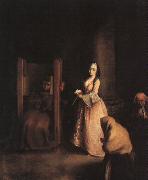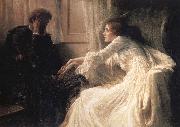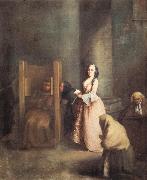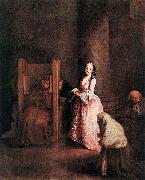
|
Pietro Longhi
|
|||
|
|
|||
| 1702-1785 Italian Pietro Longhi Galleries Pietro Longhi was born in Venice in the parish of Saint Maria, first child of the silversmith Alessandro Falca and his wife, Antonia. He adopted the Longhi last name when he began to paint. He was initially taught by the Veronese painter Antonio Balestra, who then recommended the young painter to apprentice with the Bolognese Giuseppe Maria Crespi, who was highly regarded in his day for both religious and genre painting. He was married in 1732 to Caterina Maria Rizzi. Among his early paintings are some altarpieces and religious themes. In 1734, he completed frescoes in the walls and ceiling of the hall in Ca' Sagredo, representing the Death of the giants. Henceforward, his work would lead him to be viewed in the future as the Venetian William Hogarth, painting subjects and events of everyday life in Venice. The gallant interior scenes reflect the 18th century's turn towards the private and the bourgeois. Many of his paintings show Venetians at play, such as the depiction of the crowd of genteel citizens awkwardly gawking at a freakish Indian rhinoceros (see image). This painting chronicles Clara the rhinoceros brought to Europe in 1741 by a Dutch sea captain and impresario from Leyden, Douvemont van der Meer. This rhinoceros was exhibited in Venice in 1751. There are two versions of this painting, nearly identical except for the unmasked portraits of two men in Ca' Rezzonico version. Ultimately, there may be a punning joke to the painting, since the young man on the left holds aloft the sawed off horn (metaphor for cuckoldry) of the animal. Perhaps this explains the difference between the unchaperoned women. Other paintings chronicle the daily activities such as the gambling parlors (Riddoti) that proliferated in the 18th century. In some, the insecure or naive posture and circumstance, the puppet-like delicacy of the persons, seem to suggest a satirical perspective of the artists toward his subjects. Nearly half of the figures in his genre paintings are faceless, hidden behind Venetian Carnival masks. Like Crespi before him, Longhi was commissioned to paint seven canvases documenting the seven Catholic sacraments. Longhi is well-known as a draughtsman, whose drawings were often done for their own sake, rather than as studies for paintings. Pietro's son, Alessandro, was also an accomplished painter. A paraphrase of Bernard Berenson states that "Longhi painted for the Venetians passionate about painting, their daily lives, in all dailiness, domesticity, and quotidian mundane-ness. In the scenes regarding the hairdo and the apparel of the lady, we find the subject of gossip of the inopportune barber, chattering of the maid; in the school of dance, the amiable sound of violins. It is not tragic... but upholds a deep respect of customs, of great refinement, with an omnipresent good humor distinguishes the paintings of the Longhi from those of Hogarth, at times pitiless and loaded with omens of change". | |||
|
|
|||
|
The Confession Pietro Longhi1.jpg Painting ID:: 2575 |
1755 Galleria degli Uffizi, Florence | ||
|
|
|||
|
Sir Frank Dicksee
|
|||
|
|
|||
| 1853-1928 English Sir Frank Dicksee Location English painter and illustrator. He studied in the studio of his father, Thomas Francis Dicksee (1819-95), who painted portraits and historical genre scenes; he then entered the Royal Academy Schools, London, where he was granted a studentship in 1871. He won a silver medal for drawing from the Antique in 1872 and a gold medal in 1875 for his painting Elijah confronting Ahab and Jezebel in Naboth Vineyard (untraced), with which he made his debut at the Royal Academy in 1876. He also began to work as an illustrator during the 1870s, contributing to Cassell Magazine, Cornhill Magazine, The Graphic and other periodicals. During the 1880s he was commissioned by Cassell & Co. to illustrate their editions of Longfellow Evangeline (1882), Shakespeare Othello (1890) and Romeo and Juliet (1884). | |||
|
|
|||
|
The Confession new3/Sir Frank Dicksee-249754.jpg Painting ID:: 28408 |
1896 Oil on canvas 114.2 x 159.9 cm (45 x 63 in) Private collection (mk63) | ||
|
|
|||
|
Pietro Longhi
|
|||
|
|
|||
| 1702-1785 Italian Pietro Longhi Galleries Pietro Longhi was born in Venice in the parish of Saint Maria, first child of the silversmith Alessandro Falca and his wife, Antonia. He adopted the Longhi last name when he began to paint. He was initially taught by the Veronese painter Antonio Balestra, who then recommended the young painter to apprentice with the Bolognese Giuseppe Maria Crespi, who was highly regarded in his day for both religious and genre painting. He was married in 1732 to Caterina Maria Rizzi. Among his early paintings are some altarpieces and religious themes. In 1734, he completed frescoes in the walls and ceiling of the hall in Ca' Sagredo, representing the Death of the giants. Henceforward, his work would lead him to be viewed in the future as the Venetian William Hogarth, painting subjects and events of everyday life in Venice. The gallant interior scenes reflect the 18th century's turn towards the private and the bourgeois. Many of his paintings show Venetians at play, such as the depiction of the crowd of genteel citizens awkwardly gawking at a freakish Indian rhinoceros (see image). This painting chronicles Clara the rhinoceros brought to Europe in 1741 by a Dutch sea captain and impresario from Leyden, Douvemont van der Meer. This rhinoceros was exhibited in Venice in 1751. There are two versions of this painting, nearly identical except for the unmasked portraits of two men in Ca' Rezzonico version. Ultimately, there may be a punning joke to the painting, since the young man on the left holds aloft the sawed off horn (metaphor for cuckoldry) of the animal. Perhaps this explains the difference between the unchaperoned women. Other paintings chronicle the daily activities such as the gambling parlors (Riddoti) that proliferated in the 18th century. In some, the insecure or naive posture and circumstance, the puppet-like delicacy of the persons, seem to suggest a satirical perspective of the artists toward his subjects. Nearly half of the figures in his genre paintings are faceless, hidden behind Venetian Carnival masks. Like Crespi before him, Longhi was commissioned to paint seven canvases documenting the seven Catholic sacraments. Longhi is well-known as a draughtsman, whose drawings were often done for their own sake, rather than as studies for paintings. Pietro's son, Alessandro, was also an accomplished painter. A paraphrase of Bernard Berenson states that "Longhi painted for the Venetians passionate about painting, their daily lives, in all dailiness, domesticity, and quotidian mundane-ness. In the scenes regarding the hairdo and the apparel of the lady, we find the subject of gossip of the inopportune barber, chattering of the maid; in the school of dance, the amiable sound of violins. It is not tragic... but upholds a deep respect of customs, of great refinement, with an omnipresent good humor distinguishes the paintings of the Longhi from those of Hogarth, at times pitiless and loaded with omens of change". | |||
|
|
|||
|
The Confession new3/Pietro Longhi-923952.jpg Painting ID:: 29985 |
mk67 Oil on canvas 24x191/2in Uffizi, | ||
|
|
|||
|
Pietro Longhi
|
|||
|
|
|||
| 1702-1785 Italian Pietro Longhi Galleries Pietro Longhi was born in Venice in the parish of Saint Maria, first child of the silversmith Alessandro Falca and his wife, Antonia. He adopted the Longhi last name when he began to paint. He was initially taught by the Veronese painter Antonio Balestra, who then recommended the young painter to apprentice with the Bolognese Giuseppe Maria Crespi, who was highly regarded in his day for both religious and genre painting. He was married in 1732 to Caterina Maria Rizzi. Among his early paintings are some altarpieces and religious themes. In 1734, he completed frescoes in the walls and ceiling of the hall in Ca' Sagredo, representing the Death of the giants. Henceforward, his work would lead him to be viewed in the future as the Venetian William Hogarth, painting subjects and events of everyday life in Venice. The gallant interior scenes reflect the 18th century's turn towards the private and the bourgeois. Many of his paintings show Venetians at play, such as the depiction of the crowd of genteel citizens awkwardly gawking at a freakish Indian rhinoceros (see image). This painting chronicles Clara the rhinoceros brought to Europe in 1741 by a Dutch sea captain and impresario from Leyden, Douvemont van der Meer. This rhinoceros was exhibited in Venice in 1751. There are two versions of this painting, nearly identical except for the unmasked portraits of two men in Ca' Rezzonico version. Ultimately, there may be a punning joke to the painting, since the young man on the left holds aloft the sawed off horn (metaphor for cuckoldry) of the animal. Perhaps this explains the difference between the unchaperoned women. Other paintings chronicle the daily activities such as the gambling parlors (Riddoti) that proliferated in the 18th century. In some, the insecure or naive posture and circumstance, the puppet-like delicacy of the persons, seem to suggest a satirical perspective of the artists toward his subjects. Nearly half of the figures in his genre paintings are faceless, hidden behind Venetian Carnival masks. Like Crespi before him, Longhi was commissioned to paint seven canvases documenting the seven Catholic sacraments. Longhi is well-known as a draughtsman, whose drawings were often done for their own sake, rather than as studies for paintings. Pietro's son, Alessandro, was also an accomplished painter. A paraphrase of Bernard Berenson states that "Longhi painted for the Venetians passionate about painting, their daily lives, in all dailiness, domesticity, and quotidian mundane-ness. In the scenes regarding the hairdo and the apparel of the lady, we find the subject of gossip of the inopportune barber, chattering of the maid; in the school of dance, the amiable sound of violins. It is not tragic... but upholds a deep respect of customs, of great refinement, with an omnipresent good humor distinguishes the paintings of the Longhi from those of Hogarth, at times pitiless and loaded with omens of change". | |||
|
|
|||
|
The Confession new23/Pietro Longhi-459498.jpg Painting ID:: 70957 |
The Confession, Oil on canvas, 61 x 50 cm | ||
|
|
|||
|
Also Buy::. For Following Paintings / Artists / Products, Please Use Our Search Online: |











